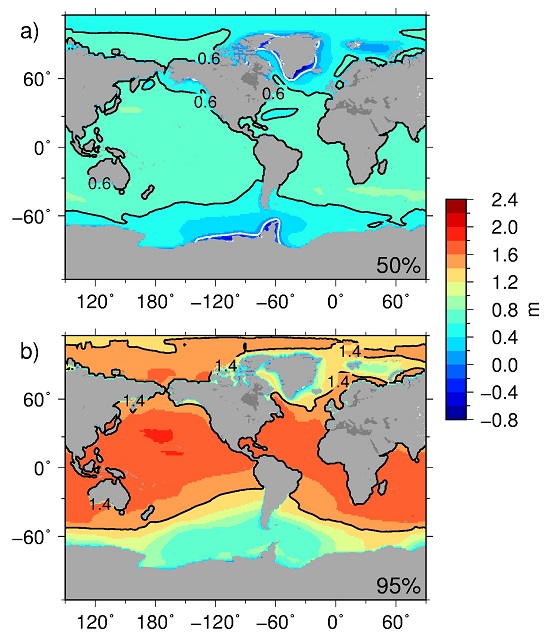Warming of 2 °C will lead to an average global ocean rise of 20 cm, but more than 90% of coastal areas will experience greater rises. If warming continues above 2 °C, then, by 2100, sea level will be rising faster than at any time during human civilization, and 80% of the global coastline is expected to exceed the upper limit of 1.8 m for mean global ocean sea level rise.
Scientists from UK, Finland, China, Netherlands and Denmark predict ocean levels could rise an average of 0.9 meters if climate change causes a 5 °C temperature rise by 2100. The scientific consensus is that a bigger rise than 2 °C rise above pre-industrial temperatures risks severe climate change impacts, including on sea level. Under both a modest greenhouse gas emission scenario (RCP4.5) and the business as usual scenario (RCP8.5), a 2 °C increase would occur between 2040 and 2050.
The study generated probabilistic sea level rise projections with global warming at and above 2 °C, including projections for 136 coastal cities. If mid-century temperatures reach 2 °C, global sea level could rise by approximately 0.2 meters, but, due to ocean dynamics, 90% of coastal areas could experience even higher sea level rise. For example, the researchers predict up to a 0.4 meter rise along the Atlantic coasts of North America and Norway. Furthermore, projected sea level rise could exceed 1.8-meters by 2100 at most of the coastal cities included in the study.
– The impact on developing world rapidly growing cities is likely to be disproportionate since they are also creating local subsidence due to ground water extraction, and often suffer from extreme floods due to tropical cyclones, says Professor John Moore of the Arctic Centre in Rovaniemi, and chief scientist at Beijing Normal University in China.
– By the mid 21st century almost all the most populated cities globally will be in what is now the developing world, the concentration of infrastructure and resources grows relatively faster in these cities, many of which are located coastal land, and indeed often have new buildings on previously undeveloped flood plane or land reclaimed from the sea."
– The difference in sea level between that expected with a 2C rise - which could be the peak temperature rise under reasonable greenhouse gas mitigation schemes, and under a 5C rise expected under business as usually by 2100 is dramatic. The difference in the upper forcastable limits (with only a 1/20 chance of occuring) is even more dramatic due to the possible large ice losses from Antarctica under high temperature rises.
The article “
Coastal sea level rise with warming above 2 °C” by Jevrejeva, S., L. P. Jackson, R.E.M. Riva, A. Grinsted, J. C. Moore is published in
Proceedings of the National Academy of Sciences.
 Figure:
Figure: Increases in regional sea level change under 5 °C warming compared with 2 °C: (A) median increases and (B) increases in the 95th percentile. Black line marks increases of (A) 0.6 m and (B) 1.4 m in global average sea level at 2100. White line is zero sea level rise.
More information:
Article:
http://www.pnas.org/content/early/2016/11/02/1605312113
Research Professor John Moore
Arctic Centre, University of Lapland
john.moore.bnu@gmail.com, +86 13 52 146 0942, +358 40 019 4850
Photo by Steve Hall/National Oceanography Centre: Thames Flood Barrier
LAY/AK/JM